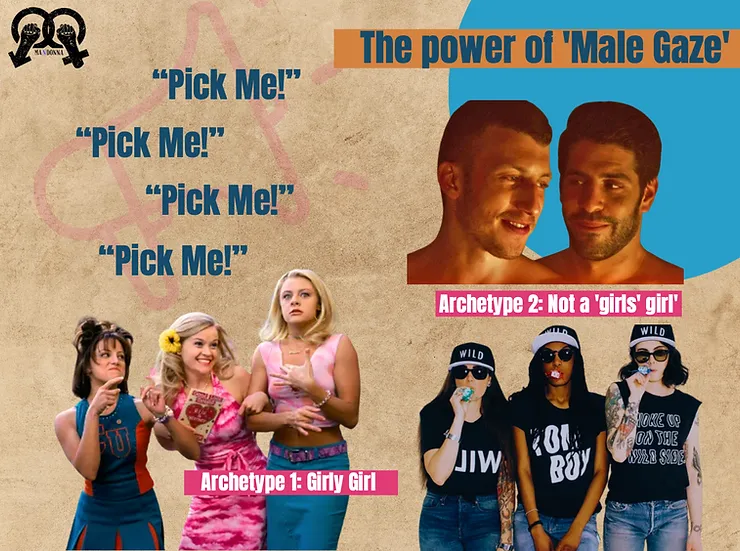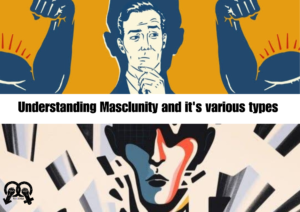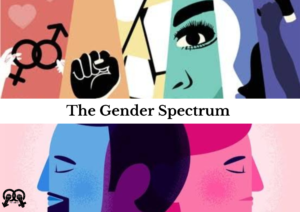Learning Outcomes:
- What is the 'Pick-me-girl' phenomenon and its various types
- What are the reasons for the occurrence of this phenomenon with particular emphasis on 'Male Gaze Theory'
- Insights into whether every woman is a 'pick me girl' and how should that make us feel
I don’t call myself a woman much anymore. When I do, I joke about being an ‘unusual woman’. Mostly for silly reasons. I keep my armpit hair. I wear green lipstick. I have ‘Resting Bitch Face’. But also for real reasons. I’m queer (duh), I don’t want to get married or have children, and I feel no warmth towards canines or infants. I know these things make me a bad ‘woman’, so I take ironic comfort in being ‘unusual’ (as does Alison Bechdel). Sometimes, I find myself feeling all uppity in my lack of usualness. I’m glad I’m an unusual woman, I think. I rather prefer it to be a usual- Oops! Did I just say I’m not like other girls, in feminist speak? Am I a ‘pick-me girl’?

The Internet’s ‘Pick-Me Girl’
The ‘pick-me girl’ has been an internet sensation for a while now. As uncomfortable characters in TikTok skits go, she’s incredibly (un)popular. Usually, she’s a straight woman who leans into or distances herself from traditional femininity to compete with other women for male validation. TikTok ‘pick-me girl’ parodist @Hannah.Montoya has delineated these two styles of ‘pick-me’ behaviour by having them clash with one another.
Cassidy goes out of her way to demonstrate her proximity to traditional femininity while Jocelyn does the opposite, making it clear that she’s ‘not like other girls’. Their tactics are different, but they both want to triumph over the other in the form of Jaden’s approval. It is their hostility to one another and their meaningless veneration of Jaden (who, frankly, seems like a standard buffoon who couldn’t care less) that makes them equally ridiculous – and equally bad feminists.
The internet’s ‘pick-me girl’ usually combines these tactics. @RiriBibi_’s ‘pick-me girl’, for instance, is both ‘the only girl at the skatepark (again 🙄)’ and too petite for an XS sweatshirt. She mostly wants to be ‘picked’, so she boasts about whatever she thinks makes her exceptional to men, whether that’s her affinity for video games or her minuscule hands. Somehow, this agenda almost always includes putting down other women for not being like her.
But, Why does this happen?
‘Pick-me’ behaviour generally stems from the internalised male gaze. Like all women, ‘pick-me girls’ are wired to understand themselves through archetypes, but find it difficult to embody them without performing for the male gaze. Sarah McGrath details beautifully in her article for the Brown Daily Herald how female identity has become inseparable from the world of archetypes:
‘When you grow up seeing women represented almost solely through reductive archetypes, you can’t help but understand yourself through similar patterns. Not just as a girl, but as a type of girl. I’m not just feeling strong or uber-productive, I’m in my Hermione-Granger–Olivia-Pope–Elle-Woods era. I’m not just a writer, I’m in my Carrie-Bradshaw–Jo-March–Rory-Gilmore era.’
– Sarah McGrath, The Plight of the Pick-Me Girl
So the woman is always an archetype, a ‘type of girl’. This alone isn’t all bad, but most female archetypes are frequently portrayed through the perspective of a male audience, if not created for one, which evokes the internalised male gaze.
On one hand, traditional archetypes like the ‘Girly Girl’ and the ‘Girl Next Door’ meet patriarchal society’s expectations of femininity, while non-traditional or not-like-other-girls archetypes like the ‘Tomboy’, the ‘Smart Girl’, and the ‘Manic Pixie Dream Girl’ somehow defy. ‘Pick-me girls’ like Cassidy realise this, so they draw attention to their daintiness or their (real or exaggerated) inability to open a jar to seem desirable in the presence of men. On the other hand, traditional archetypes are often devalued or scorned by patriarchal society and not-like-other-girls archetypes are portrayed as superior to them. Heterosexual romance narratives also modify not-like-other-girls archetypes to pander to the male gaze, making ‘Tomboys’ sexy (see the ‘Cool Girl’ trope), ‘Manic Pixie Dream Girls’ dream-like, and ‘Smart Girls’…take off their glasses. So ‘pick-me girls’ like Jocelyn draw attention to their love for cars or sports, their ‘edgy’ taste in music, or their ‘books over looks’ disposition. ‘Pick-me girls’ like @RiriBibi_’s do both, drawing attention to their simultaneous proximity to and deviation from traditional femininity.
On the Male Gaze Theory & the ‘Pick-Me-Girl’ Phenomenon
There is nothing wrong with any female archetype in itself. But female archetypes filtered through the male gaze so much that regardless of which one(s) she identifies with, the ‘pick-me girl’ associates it with male validation - and female competition.
No, she’s not being particularly intelligent. But she’s a victim of her circumstances. That’s why we need to empathise with the ‘pick-me girl’, in all her incarnations. When we ridicule her, we’re creating our own not-like-other-girls archetype (the ‘Good Feminist’) to put her down, which is unhelpful at best, and its own kind of ‘pick-me’ behaviour at worst. We’re positioning ourselves as superior for having overcome our internalised male gaze, which is no better behaviour than hers. So while we may call out the ‘pick-me girl’ when we need to (we are good feminists), it would be wise to be empathetic in our criticism (we are good feminists). The ‘pick-me girl’ is not the enemy. Women’s choices are complex and heavily regulated by their social worlds. ‘Good Feminists’ and ‘Pick-me girls’ are in the same boat.
Other ‘Pick-Me Girls’
The unintentional ‘pick-me’ behaviour of the ‘Good Feminist’ makes me wonder if more of us participate in ‘pick-me’ behaviour than we think – and we do. The rest of us may not be trying to satisfy the male gaze or make other women look bad, yet part of us thinks our version of femaleness is better or more authentic than other women’s. So we take quiet pride in it:
- I take pride in being an ‘unusual woman’.
- My friend Farah takes pride in her practical exterior and the fact that she doesn’t date (she will have a no-nonsense arranged marriage, thank you very much; Farah is above silly things like feelings).
- My friend Kinla takes pride in her goofy antics and being ‘fun’ (the rest of us are ‘lame’ and we just need to accept that).
The more I think about it, the more women I am convinced do this. We often know we shouldn’t, in which case we’ll only voice our ‘quiet pride’ ironically, but the superiority and mild contempt we feel are real. So we’re kind of saying ’pick me’…just to no one in particular. Why?
Most of us identify with a not-like-other-girls archetype. As discussed, women are predisposed to understand themselves through archetypes. When not-like-other-girls archetypes are male gaze-free and leave room for nuance, they can actually help women who deviate from traditional femininity in order to embrace their identities. So we play into them, intentionally and otherwise (I play into the ‘Smart Girl’, the ‘Weird Girl’, and the ‘Ice Queen’). We also create new archetypes for our specific deviations. What constitutes a deviation varies across contexts (ex. while Farah’s ‘no-nonsense’ path is ‘traditional’ in conservative Indian society, dating is ‘traditional’ in her peer group), but all deviations can be translated into not-like-other-girls archetypes. The ‘Good Feminist’, for instance, deviates by rejecting female behaviour influenced by the patriarchy, and that becomes her archetype.
Through archetyping, women are able to see their deviations as lovable quirks or strengths and reclaim them. However, we also start othering traditional archetypes. By classifying ourselves as particular ‘types’ of women, we see ourselves in stark opposition to other ‘types’. We may even feel a sense of righteous indignation about being not normal and start looking down on other women for being compliant with the norms (or ‘lame’). Even when we know they’re not doing anything wrong, we feel, well, uppity. So we indulge in secret ‘pick-me’ behaviour.
This uppityness is understandable, especially in women with significant deviations. It’s definitely a disadvantage to defy norms as a woman, so women who are fat, queer, neurodivergent, etc. are allowed to feel ‘righteously indignant’, as are women who are simply unconventional or unlikeable in patriarchal society. ‘Good Feminists’ are similarly allowed to feel this way about ‘pick-me girls’ actively upholding the system they’re trying to dismantle for all women. When your identity is ostracised or unappreciated, it’s only natural to protect your pride in it by putting up (slightly spiteful) walls. That being said, we should probably find ways to live as ourselves without feeling superior. It’s not good for anybody.
We’re All Pick-Me Girls

So most ‘pick-me’ behaviour is caused by some tension between ‘traditional’ and ‘non-traditional’ femininities or female archetypes. Unfortunately, the long history of these tensions has given almost all women strong (if subconscious) feelings about the value of different kinds of femaleness, so almost all women participate in ‘pick-me’ behaviour. Either the internalised male gaze encourages them to use their particular femininity to compete with other women, or their social worlds foster their feelings of indignance and irrational superiority. Many women also just feel compelled to be special (among women), for male validation or otherwise, because of narratives that only portray female identity in contrasts and archetypes.
Patriarchal society (and its storytellers) want the real-life woman to be a character. Her every attribute needs to reflect the ‘type’ of woman she is – that’s why being a little small feels like a job well done, enjoying food feels quirky and radical, and neutrality about dogs feels victoriously unusual. But these things only make her a person, and people aren’t archetypes. Their identities are just unique mish-mashes of parts of each other. That means no woman is ‘like other girls’. ‘Other girls’ aren’t a real group of people. But we’re told they are, and we deal with it by trying to make the best of what is or isn’t ‘other girls’-y in us – if only just in our heads.
So I am a ‘pick-me girl’. One way or another we all are, and it isn’t our fault. But it’s still astronomically useless behaviour: the culture that forcibly categorises and compares us hurts all women, and the last people we should be hurting back are each other. At some point, we have to start seeing ourselves and each other as people. Maybe then we’ll get over wanting to be ‘picked’.
References
- McGrath, Sarah. 2022. “McGrath ’24: The plight of the ‘pick me’ girl.” The Brown Daily Herald, March 22, 2022. https://www.browndailyherald.com/article/2022/03/mcgrath-24-the-plight-of-the-pick-me-girl
- Rosenbluth, Amy. 2021. “The Toxic Trajectory of the #PickMeGirl Trend.” The McGill International Review, April 29, 2021. https://www.mironline.ca/the-toxic-trajectory-of-the-pickmegirl-trend/
- Hariri, Iman. 2022. “What's a Pick-Me Girl? - Pick-Me Girl Definition.” Cosmopolitan, December 2, 2022. https://www.cosmopolitan.com/sex-love/a42134933/what-is-a-pick-me-girl-definition/
- Mahan, Logan. 2021. “The Problem With TikTok’s #PickMeGirl Trend, Explained.” InsideHook, July 19, 2021. https://www.insidehook.com/article/internet/pick-me-girl-tiktok-trend-explained
- Mulvey, Laura. 1975. “Visual Pleasure and Narrative Cinema.” Screen, Volume 16, Issue 3, Pages 6–18, October 1, 1975. https://doi.org/10.1093/screen/16.3.6
Lavanya Sinha (they/she) is an undergraduate student at Yale University, originally from New Delhi. They’re majoring in Humanities, which for them means thinking of everything as a silly but important story. They also do a lot of theatre, including teaching theatre to children, and some sketch and stand-up comedy. It is through this lens of art and storytelling that they approach issues of gender and sexuality, hoping to humanise the othered with lighthearted earnestness.






